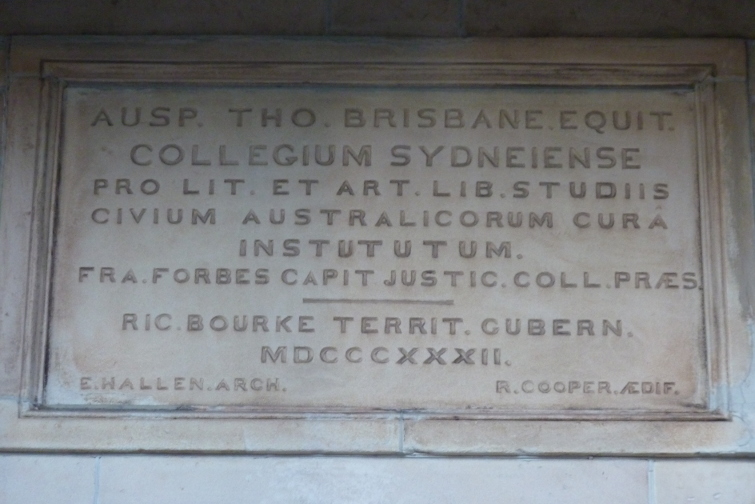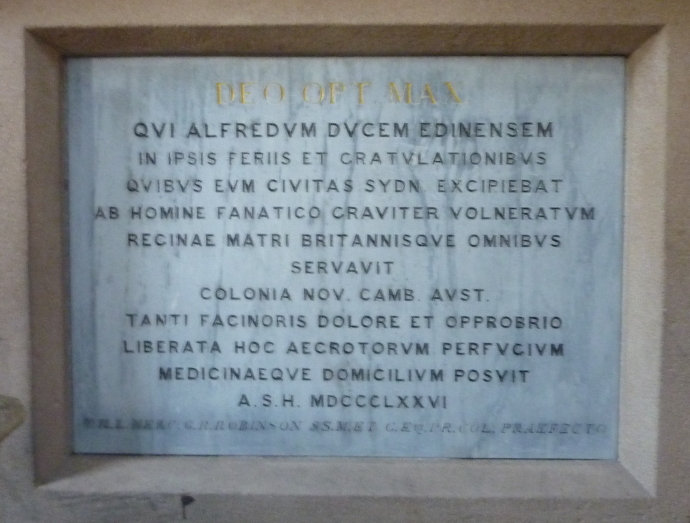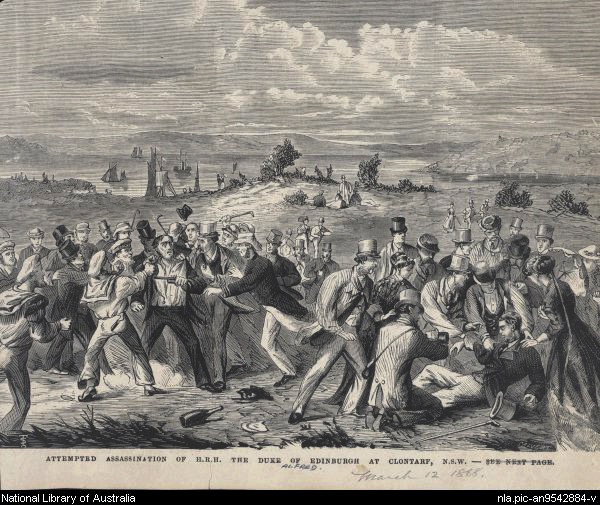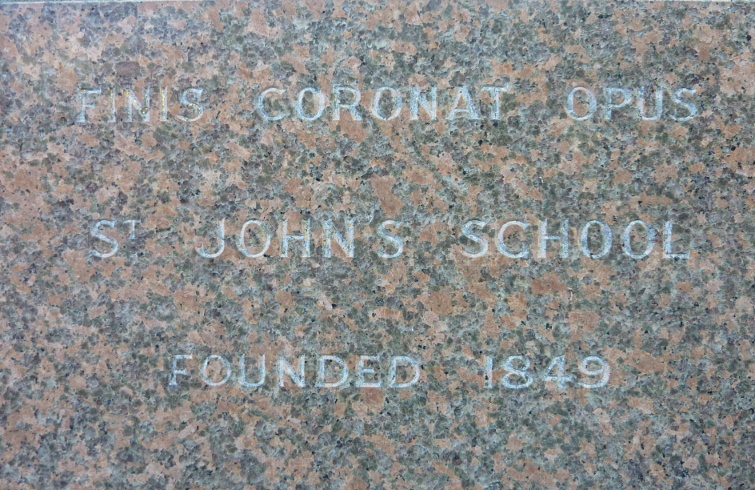Australia For Visitors > Sydney > Latin Language Inscriptions in Sydney, Australia
Latin Language Inscriptions in Sydney
Share this page:
The British colony of New South Wales was founded in 1788. In those days the Latin language was still widely used in the sciences, in law, in medicine and in inscriptions on building foundation stones, on memorial tablets, and on graves and tombstones.
In Sydney, the capital city of New South Wales, the following inscriptions in the Latin language -- testimonies to the hard work and achievement of past generations -- can still be viewed at just a short distance from the Central Business DIstrict.
(1) Sydney Grammar School, College Street, Darlinghurst

Latin Inscription at Sydney Grammar School
which can be seen from College Street and from Hyde Park
Above a door on the western side of the school, there is a stone tablet with the following Latin inscription:
AUSP. THO. BRISBANE EQUIT.
COLLEGIUM SYDNEIENSE
PRO LIT. ET ART. LIB. STUDIIS
CIVIUM AUSTRALICORUM CURA
INSTUTUTUM.
FRA. FORBES CAPIT JUSTIC. COLL. PRAES.
RIC. BOURKE TERRIT. GUBERN.
MDCCCXXXII.
E. Hallen. Arch. R. Cooper. Aedif.
This inscription may be translated as follows:
Under the patronage of Sir Thomas Brisbane
Sydney College was founded
with Chief Justice Francis Forbes as its president
for the furtherance of the study of letters and the liberal arts,
through the concern of the citizens of Australia
in the year 1832
when Richard Bourke was the Governor of the territory.
E. Hallen, Architect. - R. Cooper, Builder. [1]
Some of the Latin words in the inscription have been abbreviated for reasons of space (for example, GUBERN. is short for GUBERNATOR (English, "governor").
Interestingly, the Latin inscription includes a spelling mistake: the word INSTUTUTUM should be INSTITUTUM. Clifford Turney writes: "Whether the stonemason, architect or some other person was responsible for the mispelling... has been a matter of conjecture." [2]
The Sydney Grammar School opened its doors in 1854 and is still a major Sydney school to this day.
This school is actually a successor to earlier educational institutions that stood on the same site in College Street. The first school was the Sydney Public Free Grammar School (founded 1825) and it was followed by Sydney College (opened 1835). The Sydney College buildings were designed by the architect Edward Hallen and were built by the building contractor Robert Cooper with construction beginning in 1831. [3]
The stone tablet with its Latin inscription was placed above a doorway in the western façade of these buildings in 1832. "Hallet's original design included a long western facade with a central entrance with a handsome portico with columns. Unfortunately the portico was never constructed." [1] Above the doorway, now walled-in, a stone tablet with a Latin inscription was placed and this stone tablet is the one we can still see today.
This inscription has attracted notice over the years including from W. Cobbett who wrote a letter to the Sydney Morning Herald on 13 June 1950:
School Tablet
Sir,
During the term of an early N.S.W. Governor a tablet was erected on the building in College Street occupied by the Sydney Grammar School.
After all these years the sandstone is fretting, but the wording is in Latin. Could any of your readers, many of whom pass the place on the way to the Museum, give the English version of the inscription?
W. COBBETT.
Sydney.
An answer duly appeared in the Herald's Letters pages on 20 June 1950:
School Inscription
Sir,
I have pleasure in supplying the following translation of the Latin inscription on the College Street wall of the Sydney Grammar School, as asked for by your correspondent, W. Cobbett ("Herald," June 13):
"UNDER THE AUSPICES OF THOMAS BRISBANE, KNIGHT, SYDNEY COLLEGE WAS ESTABLISHED BY THE SOLICITUDE OF AUSTRALIAN CITIZENS FOR THE STUDY OF LITERATURE AND THE LIBERAL ARTS. FRANCIS FORBES, CHIEF JUSTICE, PRESIDENT OF THE COLLEGE.. RICHARD BOURKE, GOVERNOR OF THE TERRITORY 1832.
E. H. ALLEN [sic], ARCHITECT. R. COOPER, BUILDER."
F. G. PHILLIPS.
Sydney Grammar School.
(2) Royal Prince Alfred Hospital, Missenden Road, Camperdown

The Latin inscription on the foundation stone to the right
of the main entrance door of the Royal Prince Alfred Hospital's original building.
The foundation stone of the Royal Prince Alfred Hospital was set in place in 1876. It may still be seen on the right hand side of the main entrance of the original Royal Prince Alfred Hospital building between the Prince Albert Pavillion and the Queen Victoria Pavillion.
Its Latin words, written by Professor Charles Badham (1813–1884), [4] are as follows:
DEO OPT. MAX.
QVI ALFREDVM DVCEM EDINENSEM
IN IPSEM FERIIS ET GRATULATIONIBVS
QVIBVS EVM CIVITAS SYDN. EXCIPIEBAT
AB HOMINE FANATICO GRAVITER VOLNERATVM
REGINAE MATRI BRITANNISQVE OMNIBVS
SERVAVIT
COLONIA NOV. CAMB. AVST.
TANTI FACINORIS DOLORE ET OPPROBRIO
LIBERATA HOC AEGROTORUM PERFVCIVM
MEDICINAEQVE DOMICILIVM POSVIT
A. S. H. MDCCCLXXVI
V. ILL. HERC. G. R. ROBINSON SS.M. ET G.EQ.PR. COL. PRAEFECTO
In gratitude to God most great and most high
who, when Alfred Duke of Edinburgh
had been seriously wounded by a fanatic
during the very holidays and rejoicing
during which the city of Sydney was welcolming him,
saved him for the Queen his mother and all the Britons.
The colony of New South Wales,
freed from the pain and disgrace of so great a crime,
founded this refuge of the sick
and home of healing
in the year of our salvation 1876,
while his Excellency Sir Hercules G. R. Robinson, G.C.M., was Governor of the Colony.
Some of the Latin words have been abbreviated for reasons of space (for example, DEO OPT. MAX. is short for DEO OPTIMO MAXIMO (English, "to God most great and most high").
The inscription states, in effect, that the Royal Prince Alfred Hospital was erected as a thanksgiving to God by the people of New South Wales for the recovery of His Royal Highness Prince Alfred (then known as the Duke of Edinburgh) from the attack made on his life at Clontarf in 1868. [6]

A contemporary engraving of the "Attempted Assassination of H.R.H. the Duke of Edinburgh at Clontarf, N.S.W."
Source: National Library of Australia.
There is also a second tablet, made of marble, on the opposite side of the main entrance of the RPA Hospital's main entrance door. It is inscribed as follows:
And now abideth Faith, Hope, and Charity, these three,
but the greatest of these is Charity. [7]
(3) St. John's Church, Darlinghurst Road, Darlinghurst

Latin inscription on stone tablet opposite St. John's Church, Darlinghurst
There is a granite memorial tablet located a few metres to the south of St. John's Anglican Church, 120 Darlinghurst Road, Darlinghurst. The stone is built into a section of the brick wall that marks the dividing line between the land around the St. John's Church Rectory and the land around the St John's Hall and Office.
The stone is inscribed (with gilt lettering) with some words in English and with a Latin sentence, as follows:
FINIS CORONAT OPUS
ST. JOHN'S SCHOOL
FOUNDED 1849.
The Latin sentence may be translated as: The end crowns the work. (or, loosely translated into modern colloquial English, The final results justify all the effort expended on the project).
Given that there is currently no "St. John's School" in Darlinghurst, what does this inscription refer to and what is the story behind it?
There has been an Anglican [Church of England] presence since 1849 at and around the current site of St John's Darlinghurst. The first building at the site was a parish school/hall that was constructed in 1849 and known as St John's School and St John's Hall. That building was used as a school throughout the week, as a place of worship on Sundays and as a meeting hall on other occasions.
The granite memorial tablet is believed to have been originally created and placed on or beside that 1849 parish school/hall building.
In those early years a new sandstone church, known as St John's Darlinghurst, was slowly built just to the south of the school/hall. The spire was added in about 1871-73. At some point church services began to be held in the new church building while the 1849 building continued to be used as a school and a meeting hall.
In the early 1960s the 1849 St John's School/Hall was demolished and a Caltex service station built on the site. (The service station building was later converted for use as a car wash. In 2017 the building was demolished to make way for an aged care facility for homeless people with high care needs -- a joint project of St John's Darlinghurst and HammondCare.)
It is believed that the granite memorial tablet was removed from the 1849 building when it was demolished in the early 1960s. The tablet was relocated to a brick wall separating the St John's Rectory and a new Community Hall located just to the south of the St John's Darlinghurst church. The memorial tablet remains in that spot to this day.
When the 1849 building was demolished, the school ceased operating and the hall functions moved to the a new brick building known as St John's Hall and Office (built south of the church and dedicated by the Right Reverend Marcus Loane in 1966).
(For more information about the history of the history of St John's Darlinghurst, click here.)
(4) The University of Sydney, Camperdown
There are so many Latin (and Greek) inscriptions to be found around the campus of Sydney University that a booklet has been written on the subject:
The Writing on the Wall: The Greek and Latin Inscriptions of the University of Sydney by Kevin Lee and Anne Rogerson. Sydney, The University of Sydney Publications Office, 2002. Introduction by Dexter Hoyos.
Footnotes
1. Clifford Turney, Grammar: A History of Sydney Grammar School, 1819-1988. Sydney, Sydney Grammar School in association with Allen & Unwin, 1988, p. 14.
2. ibid., p. 426, footnote 82.
3. ibid., p. 13.
4. Royal Prince Alfred Hospital: 125 Year Anniversary. Sydney, Royal Prince Alfred Hospital, 2007. p. 19.
5. ibid., p. 19.
6. R. P. A. [journal], September 1938, p. 42.
7. ibid., p. 42.
Share this page:
|